The Ultimate Guide to Alaska Roll Sushi: A Culinary Masterpiece
What is Alaska Roll Sushi?
Definition and Origin
The Alaska roll sushi is a popular sushi dish that combines fresh salmon with creamy avocado and crunchy cucumber, all beautifully wrapped in seasoned sushi rice. This delightful roll is often seen in sushi restaurants across the United States and has consequently gained a loyal following among sushi lovers. It is believed to have originated as chefs began experimenting with local ingredients, particularly the high-quality salmon sourced from the cold waters of Alaska. Notably, the name “Alaska” reflects the use of this premium fish, which is renowned for its rich flavor and tender texture.
Key Ingredients to make Alaska roll sushi
When it comes to making a delicious Alaska roll sushi, the key ingredients play a vital role. The main components include:
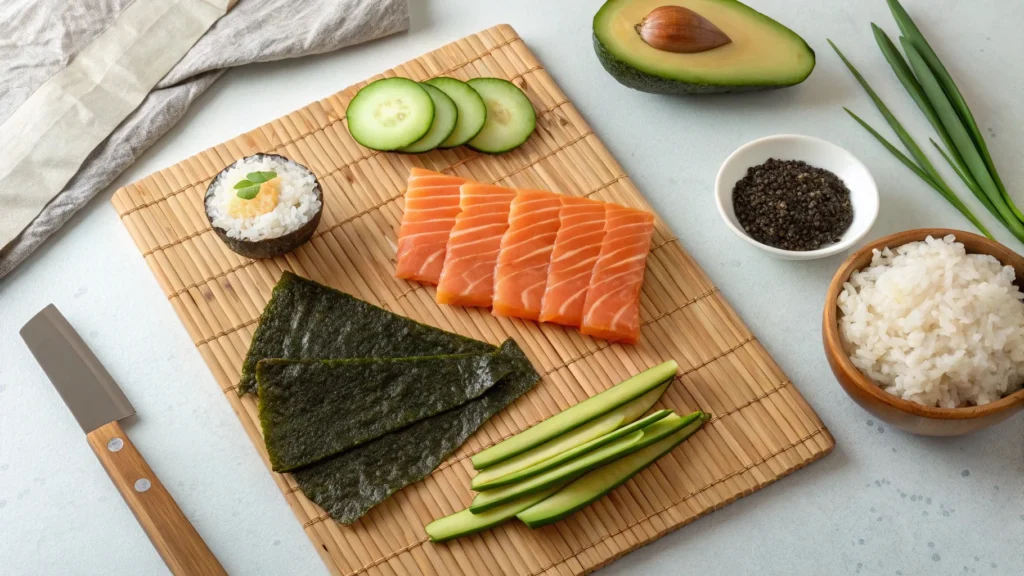
- Fresh Salmon: The star of the show, salmon provides a rich and buttery flavor.
- Avocado: This creamy fruit adds a smooth texture and balances the flavors.
- Cucumber: The cucumber offers a refreshing crunch, enhancing the overall experience.
- Sushi Rice: Seasoned rice is essential for holding the roll together and providing a base of flavor.
- Nori: This seaweed wrap holds everything together and adds a hint of umami.
These ingredients come together to create a sushi roll that is not only visually appealing but also bursting with flavor.
Unique Characteristics
One of the unique characteristics of Alaska roll sushi is its simplicity. Unlike some sushi rolls that may include a variety of ingredients, the Alaska roll focuses on the harmonious combination of salmon, avocado, and cucumber. This allows the natural flavors of the ingredients to shine through. Additionally, many people enjoy the versatility of this roll, as it can be served in various styles, from traditional to modern fusion.
Ingredients Breakdown
Premium Salmon Selection
Selecting the right salmon is crucial for making the best Alaska roll sushi. When shopping for salmon, look for sushi-grade fish, which means it is fresh and safe to eat raw. Here are some tips for choosing the best salmon:
- Color: Look for vibrant, deep pink or orange color, which indicates freshness.
- Texture: The salmon should feel firm to the touch, without any mushiness.
- Smell: Fresh salmon has a mild ocean scent. If it smells overly fishy, it’s best to avoid it.
Wild-caught salmon from Alaska is often considered the best choice due to its rich flavor and high omega-3 fatty acid content. However, farmed salmon can also be a good option if sourced from reputable suppliers.
Rice Preparation Techniques
The foundation of any great sushi roll is perfectly cooked sushi rice. To prepare sushi rice, follow these steps:
- Rinse the Rice: Start by rinsing the sushi rice under cold water until the water runs clear. This removes excess starch and helps achieve the right texture.
- Cook the Rice: Cook the rice according to the package instructions. A rice cooker is ideal for this, as it ensures even cooking.
- Season the Rice: Once the rice is cooked, transfer it to a large bowl and let it cool slightly. In a separate bowl, mix rice vinegar, sugar, and salt, then gently fold this mixture into the rice. This seasoning gives the rice its signature flavor.
- Cool the Rice: Allow the seasoned rice to cool to room temperature before using it to make sushi rolls.
Essential Accompaniments
Accompaniments are important when serving Alaska roll sushi. They enhance the flavors and provide a complete dining experience. Common accompaniments include:
- Pickled Ginger: This tangy condiment cleanses the palate between bites.
- Wasabi: For those who enjoy a kick of heat, wasabi adds a spicy element that pairs well with the richness of salmon.
- Soy Sauce: A classic dipping sauce that adds umami flavor to each bite.
These accompaniments not only complement the sushi but also add depth to the overall meal.
Nori and Wrapper Options
While traditional Alaska roll sushi uses nori (seaweed) as a wrapper, there are alternative options available for those who may not enjoy nori’s flavor or texture. Some popular alternatives include:
- Soy Paper: A gluten-free option that is slightly sweeter than nori and comes in various colors.
- Cucumber Slices: Thinly sliced cucumbers can be used as a fresh and crunchy wrapper, perfect for a lighter sushi roll.
- Rice Paper: Often used in Vietnamese cuisine, rice paper can provide a different texture and flavor profile.
These alternative wrappers allow for creativity in presentation and cater to different dietary preferences.
Step-by-Step Preparation Method
Sushi Rice Cooking
To make Alaska roll sushi, the first step is to prepare the sushi rice. Here’s a detailed guide to cooking the rice:
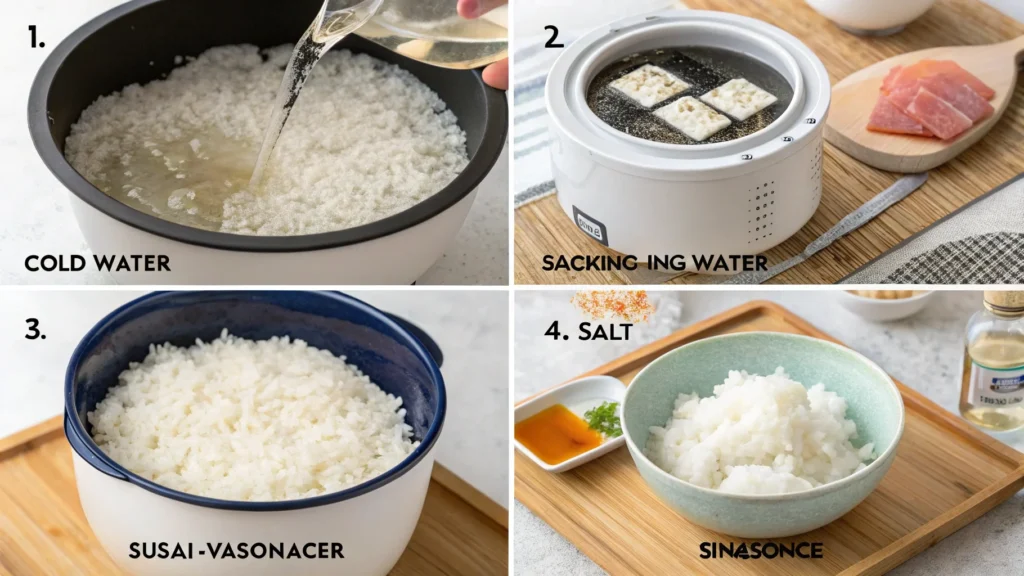
- Measure the Rice: Use a measuring cup to measure out the desired amount of sushi rice. Typically, one cup of rice will yield about two rolls.
- Rinse Thoroughly: Place the rice in a fine-mesh strainer and rinse it under cold running water. Swirl the rice with your hand to ensure all grains are rinsed. Continue rinsing until the water runs clear.
- Soak the Rice: After rinsing, soak the rice in fresh water for about 30 minutes. This step helps the rice absorb moisture and cook evenly.
- Cook the Rice: Drain the soaked rice and transfer it to a rice cooker. Add the appropriate amount of water (usually a 1:1 ratio of rice to water). If you don’t have a rice cooker, you can cook the rice on the stovetop. Bring it to a boil, then reduce the heat to low, cover, and simmer for about 20 minutes.
- Season the Rice: Once the rice is cooked, transfer it to a large bowl. In a small saucepan, combine rice vinegar, sugar, and salt. Heat gently until the sugar dissolves, then drizzle this mixture over the warm rice. Gently fold the rice with a spatula to ensure even seasoning.
- Cool the Rice: Allow the rice to cool to room temperature before using it to make sushi rolls.
Salmon Preparation
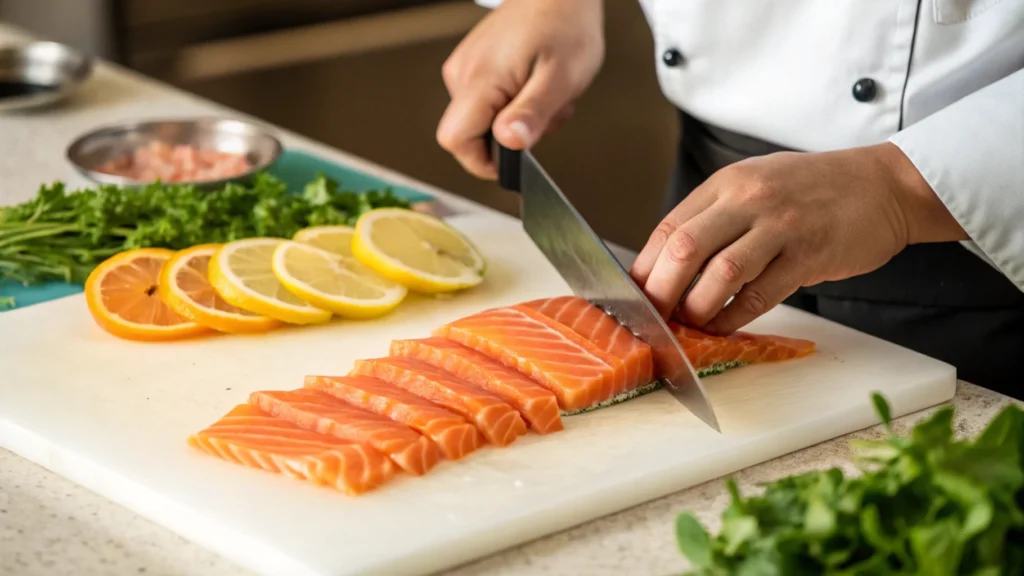
Preparing the salmon for your Alaska roll sushi is straightforward. Follow these steps:
- Select Fresh Salmon: Choose sushi-grade salmon, ensuring it meets the quality standards mentioned earlier.
- Slice the Salmon: Using a sharp knife, slice the salmon into thin strips. Aim for pieces that are about ½ inch wide. The thickness can vary based on personal preference, but consistency is key for even rolling.
- Remove Skin (if necessary): If your salmon has skin, you may want to remove it before slicing. Use a sharp knife to carefully cut along the skin, separating it from the flesh.
- Keep it Fresh: Store the sliced salmon in the refrigerator until you are ready to assemble the sushi rolls.
Rolling Techniques of Alaska roll sushi
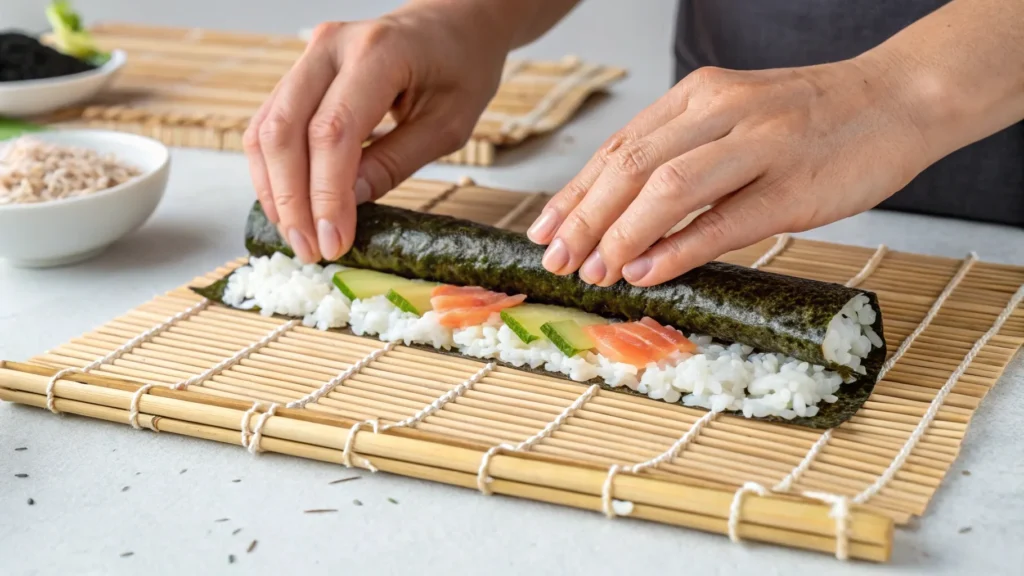
Rolling sushi can be an art form, but with practice, anyone can master it. Here’s a step-by-step guide to rolling your Alaska roll sushi:
- Prepare Your Workspace: Lay out a bamboo sushi mat on a clean surface. Have a bowl of water nearby to wet your hands and prevent the rice from sticking.
- Place the Nori: Take a sheet of nori and place it shiny side down on the bamboo mat.
- Spread the Rice: Wet your hands and grab a handful of sushi rice. Spread it evenly over the nori, leaving about an inch of space at the top edge. Press the rice down gently but firmly to ensure it sticks.
- Add Fillings: Arrange a few strips of salmon, avocado, and cucumber in a line across the center of the rice. Be careful not to overfill, as this can make rolling difficult.
- Begin Rolling: Starting from the edge closest to you, lift the bamboo mat and begin to roll the sushi away from you. Use gentle pressure to keep the roll tight as you go.
- Seal the Roll: Once you reach the exposed edge of the nori, wet it with a little water to help seal the roll. Continue rolling until the sushi is completely sealed.
- Cut the Roll: Using a sharp knife, slice the roll into bite-sized pieces. Wipe the knife with a damp cloth between cuts to ensure clean edges.
Cutting and Presentation of Alaska roll sushi
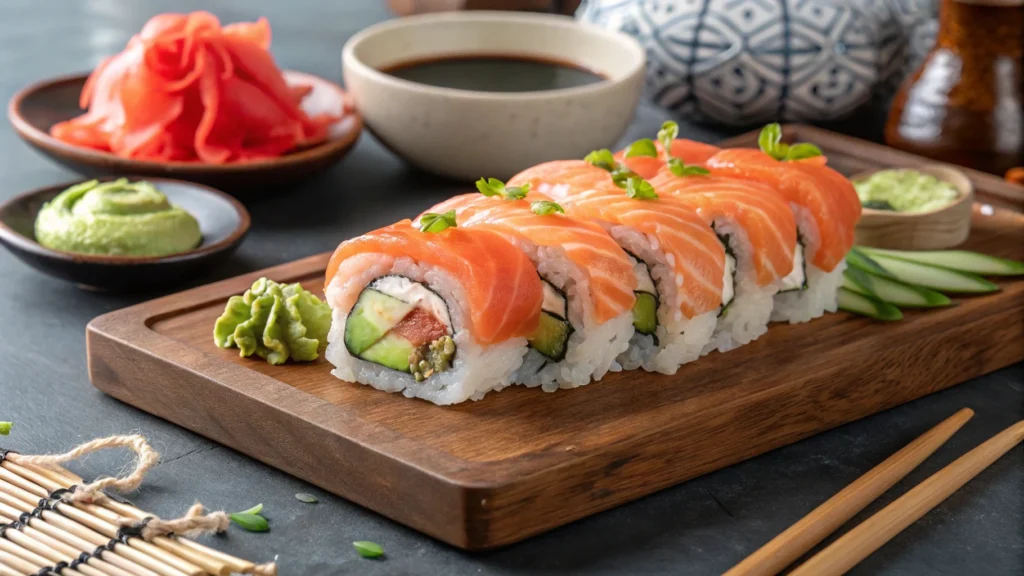
Presentation is key when serving Alaska roll sushi. Here are some tips for cutting and presenting your sushi:
- Use a Sharp Knife: A sharp knife is essential for cutting sushi rolls. A dull knife can crush the roll and make it look unappealing.
- Cut in Half First: Start by cutting the roll in half. This makes it easier to manage when cutting into smaller pieces.
- Slice into Pieces: After halving the roll, cut each half into 4-6 pieces, depending on your desired size. Aim for uniform pieces for a polished look.
- Arrange on a Platter: Place the sushi pieces on a serving platter. Consider garnishing with sesame seeds, microgreens, or thinly sliced green onions for added color and flavor.
- Serve with Accompaniments: Don’t forget to include pickled ginger, wasabi, and soy sauce on the side for dipping. These elements enhance the flavor and provide a complete sushi experience.
Flavor Profiles and Variations about Alaska roll sushi
Traditional Alaska Roll
The traditional Alaska roll sushi features a simple yet delicious combination of salmon, avocado, and cucumber. In fact, this classic version allows the natural flavors of the ingredients to shine through beautifully. Moreover, the rich taste of the salmon pairs exceptionally well with the creamy avocado, while the cucumber adds a refreshing crunch that balances the textures. Consequently, many sushi enthusiasts appreciate the straightforwardness of this roll, which ultimately makes it a staple on sushi menus across various restaurants.
Modern Fusion Styles
In recent years, innovative chefs have introduced modern fusion styles of Alaska roll sushi, which have gained popularity among food enthusiasts. These exciting variations often include unique ingredients or sauces that elevate the traditional roll to new heights. For instance, some chefs experiment with spicy mayo or eel sauce, enhancing the flavor profile significantly. Additionally, some fusion styles incorporate ingredients like cream cheese or mango, adding a delightful twist to the classic combination. As a result, these creative interpretations have broadened the appeal of Alaska roll sushi, attracting a wider audience eager to try something new.
- Spicy Alaska Roll: This variation adds spicy mayo or sriracha to the filling or as a topping, providing a kick of heat.
- Tempura Alaska Roll: In this version, the salmon is lightly battered and fried, adding a crispy texture to the roll.
- Cream Cheese Alaska Roll: Some sushi lovers enjoy adding cream cheese for a creamy twist that complements the salmon.
These modern takes on the Alaska roll offer exciting new flavors and textures, appealing to adventurous eaters.
Vegetarian Alternatives
For those who prefer a vegetarian option, you might consider making a vegetarian Alaska roll sushi using ingredients like cucumber, avocado, and carrots. Not only do these alternatives maintain the essence of sushi, but they also cater to different dietary preferences. Furthermore, these ingredients provide a delicious and satisfying flavor profile without compromising on taste. Here are some ideas for vegetarian fillings that you can experiment with:
- Cucumber: Thinly sliced cucumber adds a refreshing crunch.
- Avocado: Creamy avocado is a must-have for its rich texture.
- Carrots: Julienne carrots provide sweetness and color.
- Bell Peppers: Sliced bell peppers can add a sweet and crunchy element.
These vegetarian rolls can be just as satisfying and flavorful as their seafood counterparts.
Sauce Pairings
Sauces can significantly enhance the flavor of Alaska roll sushi. Common pairings include:
- Spicy Mayo: A blend of mayonnaise and sriracha, spicy mayo adds a creamy heat that complements the salmon.
- Eel Sauce: This sweet and savory sauce adds depth and richness to the roll.
- Ponzu Sauce: A citrus-based sauce that adds brightness and acidity, perfect for balancing the richness of the salmon.
Experimenting with different sauces can elevate your sushi experience and add an extra layer of flavor.
Nutritional Information of Alaska roll sushi
Calorie Breakdown
When considering the nutritional aspects of Alaska roll sushi, it’s important to note that the calorie content can vary based on the ingredients used. On average, a standard Alaska roll contains approximately 250-350 calories per serving, depending on portion sizes and additional toppings. Here’s a rough breakdown of the calories in a typical Alaska roll:
- Salmon: Approximately 100 calories per ounce.
- Avocado: About 50 calories per half avocado.
- Sushi Rice: Roughly 200 calories for one cup of cooked rice.
- Nori: Negligible calories.
Health Benefits
Alaska roll sushi offers several health benefits, primarily due to its key ingredients. Salmon is rich in omega-3 fatty acids, which are known for their heart-healthy properties. These healthy fats can help reduce inflammation and improve overall heart health. Additionally, avocado provides healthy fats and fiber, contributing to digestive health and satiety.
Moreover, sushi rice is a good source of carbohydrates, providing energy for your body. When enjoyed in moderation, Alaska roll sushi can be a nutritious and satisfying meal.
Dietary Considerations
When preparing Alaska roll sushi, it’s essential to consider dietary restrictions. For gluten-free options, choose gluten-free soy sauce and alternative wrappers. Always ensure that the ingredients used are safe for those with allergies or dietary limitations. Here are some considerations:
- Gluten-Free: Use gluten-free soy sauce and alternative wrappers if needed.
- Dairy-Free: Most traditional sushi ingredients are dairy-free, but be cautious with sauces that may contain dairy.
- Nut Allergies: Ensure that no nut-based ingredients are used, especially in sauces or toppings.
By being mindful of dietary restrictions, you can create a sushi experience that everyone can enjoy.
Expert Tips and Tricks of Alaska roll sushi
Professional Chef Recommendations
To perfect your Alaska roll sushi, consider tips from professional chefs. Here are some expert recommendations:
- Practice Your Rolling Technique: Rolling sushi takes practice. Don’t be discouraged if your first few rolls aren’t perfect. With time, you’ll become more skilled.
- Keep Ingredients Fresh: Always use the freshest ingredients possible. This will greatly enhance the flavor of your sushi.
- Experiment with Flavors: Don’t be afraid to try new ingredients or sauces. Sushi is all about creativity and personal taste.
Common Mistakes to Avoid
Avoid common mistakes when making Alaska roll sushi. Here are some pitfalls to watch out for:
- Overfilling the Roll: Using too much filling can make it difficult to roll and may lead to a messy outcome.
- Not Wetting Your Hands: Wetting your hands prevents the rice from sticking to your fingers, making the rolling process easier.
- Cutting with a Dull Knife: A dull knife can crush the roll and ruin its appearance. Always use a sharp knife for clean cuts.
By being aware of these common mistakes, you can improve your sushi-making skills and enjoy better results.
If you’re looking for a delicious alternative, you can also try making smoked salmon sushi rolls. Check out this smoked salmon sushi roll recipe for inspiration.
Equipment Recommendations
Investing in the right equipment can significantly improve your sushi-making experience. Here are some essential tools to consider:
- Bamboo Sushi Mat: A must-have for rolling sushi, it helps create tight and even rolls.
- Sharp Knife: A good-quality knife is essential for cutting sushi rolls cleanly.
- Rice Cooker: While not necessary, a rice cooker can make cooking sushi rice easier and more consistent.
Having the right tools will make the preparation process smoother and more enjoyable.
Serving and Pairing Suggestions about Alaska roll sushi
Accompaniment Recommendations
When serving Alaska roll sushi, consider pairing it with traditional accompaniments like pickled ginger and wasabi. These elements not only enhance the flavor but also provide a refreshing contrast to the richness of the salmon. Here are some additional accompaniment ideas:
- Sesame Seeds: Sprinkle toasted sesame seeds on top of the sushi for added flavor and texture.
- Microgreens: Garnish with microgreens for a fresh and vibrant touch.
- Radish Slices: Thinly sliced radishes can add a peppery crunch to the plate.
These accompaniments not only enhance the overall experience but also make for an aesthetically pleasing presentation.
Beverage Pairings
The right beverage can complement your Alaska roll sushi beautifully. Consider serving it with:
- Green Tea: A classic pairing that enhances the flavors of sushi and aids digestion.
- Sake: This Japanese rice wine is a traditional accompaniment to sushi and comes in various styles.
- Light White Wine: A crisp, light white wine can also pair well, balancing the richness of the salmon.
Choosing the right beverage can elevate your sushi experience and make the meal more enjoyable.
Plating Techniques
Presentation is key when serving Alaska roll sushi. Here are some tips for plating:
- Use a Clean Platter: Choose a clean, simple platter to showcase your sushi.
- Arrange Neatly: Place the sushi pieces in a neat row or circular pattern for an elegant look.
- Add Color: Incorporate colorful garnishes like microgreens or radish slices to make the dish visually appealing.
A well-presented dish not only looks inviting but also enhances the overall dining experience.
Frequently Asked Questions about Alaska roll sushi
Ingredient Substitutions
If you’re missing certain ingredients for your Alaska roll sushi, consider substitutions. Here are some options:
Salmon: If salmon is unavailable, consider using tuna or cooked shrimp for a different flavor.
Avocado: If you don’t have avocado, you can use cream cheese for a creamy texture.
Cucumber: Zucchini can be a good substitute for cucumber if you want a similar crunch.
These substitutions can help you create a delicious sushi roll even when some ingredients are not on hand.
Storage Tips
To maintain the freshness of your Alaska roll sushi, store it properly. Here are some storage tips:
Refrigerate: Place the sushi in an airtight container and store it in the refrigerator. Consume it within 24 hours for the best taste and quality.
Avoid Freezing: Freezing sushi is not recommended, as it can alter the texture of the rice and fish.
By following these storage tips, you can enjoy your sushi for longer while maintaining its quality.
Preparation Time
Preparing Alaska roll sushi typically takes about 45 minutes to an hour, depending on your experience level and the complexity of the roll. Here’s a rough breakdown of the time involved:
Rice Preparation: 20-30 minutes (including rinsing and cooking).
Ingredient Preparation: 10-15 minutes (slicing salmon and vegetables).
Rolling and Cutting: 15-20 minutes (rolling the sushi and cutting it into pieces).
With practice, you can streamline the process and create delicious sushi in no time.
Conclusion: Master the Art of Alaska Roll Sushi
In conclusion, mastering the art of Alaska roll sushi requires not only practice and patience but also a genuine passion for culinary exploration. By understanding the key ingredients, preparation techniques, and flavor profiles, you can create a sushi masterpiece that truly delights your taste buds. Whether you prefer the traditional version or opt for modern variations, the Alaska roll is sure to impress anyone who tries it. Therefore, enjoy the process of making sushi at home, and savor the delicious results that come from your efforts!

